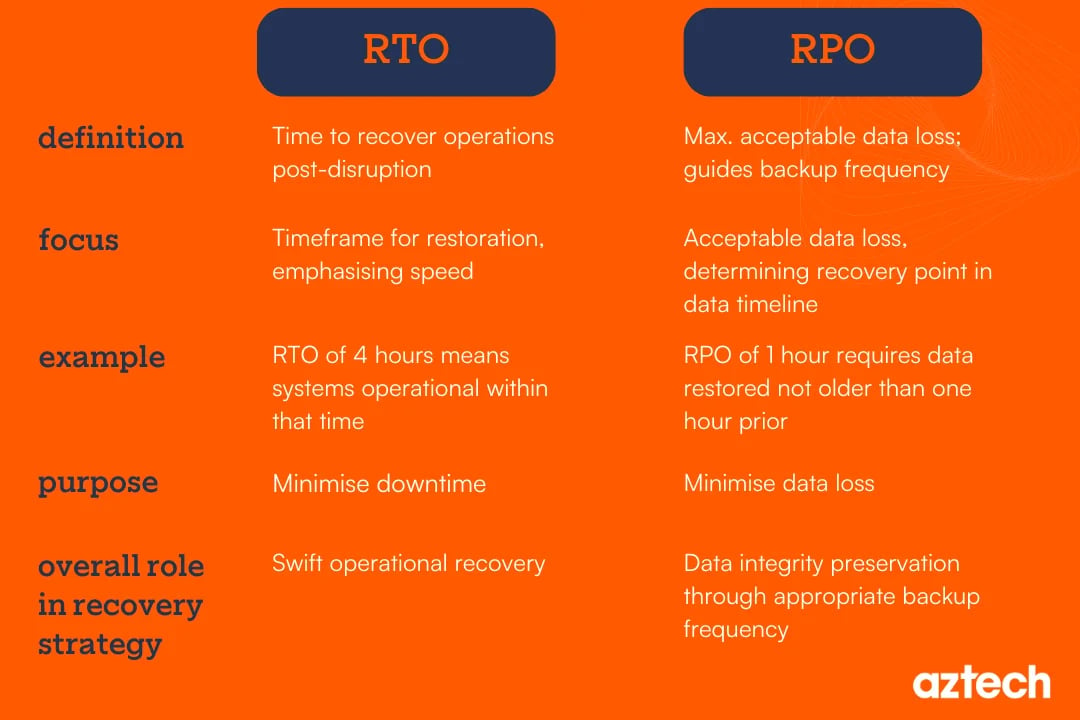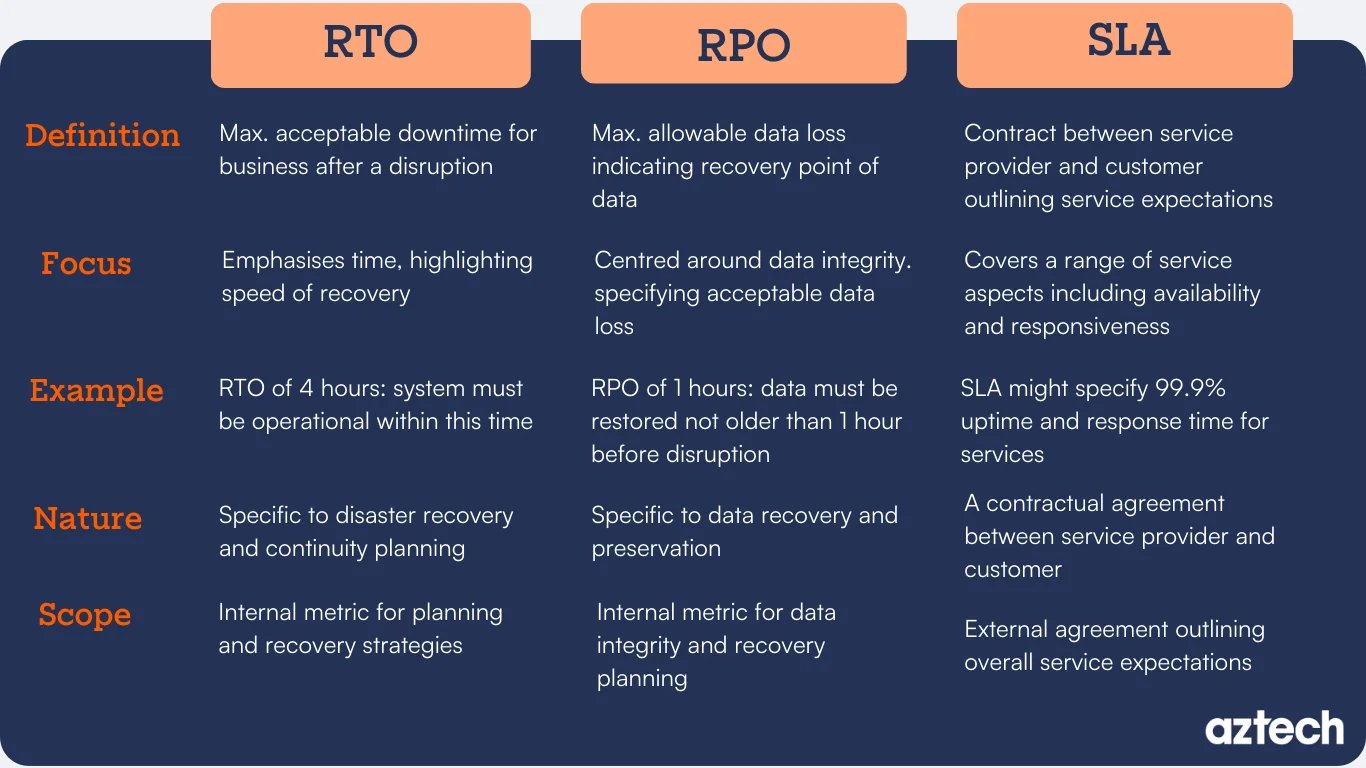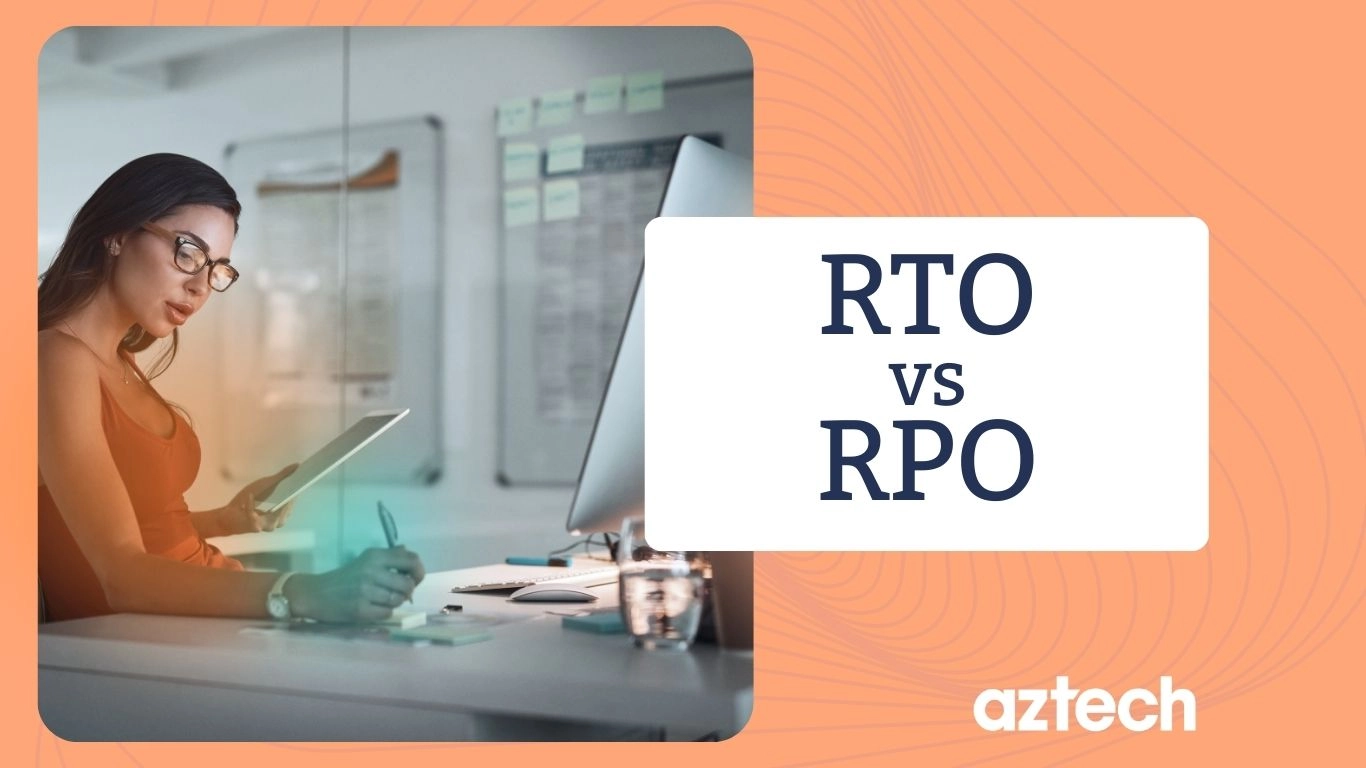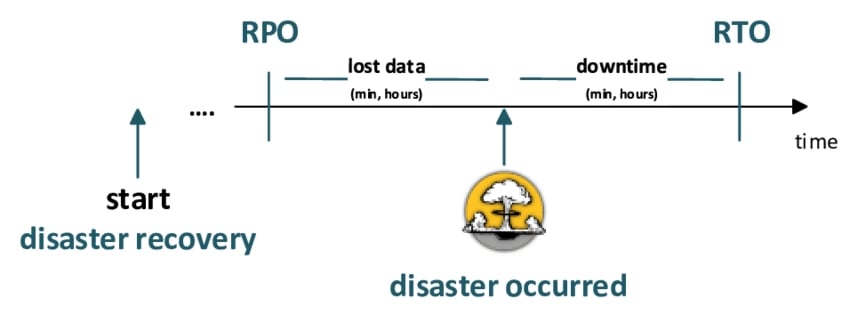Are you wondering what the differences between RPO (Recovery Point Objective), and RTO (Recovery Time Objective) are in terms of a business continuity plan?
If so, then you have come to the right place!
In this blog post, we will explore the major differences between RPO and RTO, these two disaster recovery strategies with examples, and how businesses can choose an appropriate one for their needs.
With a clear understanding of how each approach works, senior management will be equipped with the knowledge on how to determine if either RPO or RTO is right for their normal business operations.
Read on to find out more!
Key Takeaway
- RTO deals with the time it takes to recover and resume operations.
- RPO deals with the allowable data loss and determines the frequency of data backups.
Understanding the Recovery Objectives
Let's dive into the world of recovery objectives—it's like the superhero duo of business continuity plans. Imagine them as your trusty sidekicks: the Recovery Time Objective (RTO) and the Recovery Point Objective (RPO).
In simple words, RTO is like the ticking clock, telling you how quickly you need to bounce back after a disaster to avoid major chaos.
Meanwhile, the RPO is your data guardian, deciding how far back in time you can rewind without losing your digital cool.
So, why should you care?
Well, these dynamic duos are the backbone of a solid disaster recovery strategy and business continuity planning that keeps your business afloat during disruptions.
RTO ensures you're back on your feet fast, and RPO makes sure you haven't lost your digital treasure.
Furthermore, when combined with a business impact analysis, RPO and RTO serve as the foundation for recognising, evaluating, and elucidating effective strategies to be incorporated into business continuity and disaster recovery planning.
While RPO and RTO are essential for minimising downtime and critical data loss, they serve distinct purposes.
Let’s check them out!
What Sets Them Apart?
Recovery Point Objective - Simple Definition
RPO signifies the maximum allowable data loss after a disruption. It represents the point in time to which data must be recovered to resume normal operations.
Recovery Time Objective - Simple Definition
RTO refers to the maximum acceptable downtime for a system or business process after a disruption. It represents the time it takes to restore operations to a predefined level of functionality.
Major Differences Explained

1. RTO:
Definition: RTO refers to the maximum acceptable downtime for a system or business process after a disruption. It represents the time it takes to restore operations to a predefined level of functionality.
Focus: RTO emphasises the time aspect, highlighting how quickly a business needs to recover to avoid significant operational impact.
Example: If an organisation sets an RTO of 4 hours, it means that in the event of a disruption, systems must be restored and operational within that timeframe.
2. RPO:
Definition: RPO signifies the maximum allowable data loss after a disruption. It represents the point in time to which data must be recovered to resume normal operations.
Focus: RPO is centred around data integrity, specifying how much data loss is acceptable before recovery. It helps determine the frequency of data backups.
Example: If an organisation sets an RPO of 1 hour, it means that, in the event of a data loss incident, data must be restored to a state no older than one hour before the disruption occurred.
How to determine RTO and RPO with Examples
Recovery Time Objective (RTO)
Identify Critical Systems:
Identify the critical systems and applications that are essential for your business operations.
Assess Downtime Impact:
Understand the impact of downtime on your business in terms of revenue, customer satisfaction, and operational disruption.
Set RTO Based on Impact Tolerance:
Determine the maximum tolerable downtime for each critical system.
Set realistic RTO goals based on the impact assessment.
Formula:
RTO = Time taken to restore a system to full functionality after a disruption.
RTO Example
Scenario: Online Retailer's Server Crash
Imagine an online retailer that experiences a server crash during peak shopping hours.
The RTO for this business is set at 2 hours. In this context, RTO is the maximum acceptable downtime. The clock starts ticking the moment the server crashes. The organisation must restore its systems and website functionality within the next 2 hours to meet its RTO.
For the first hour, the IT team works diligently to identify the issue and initiate the recovery process. By the end of the second hour, the website is fully operational again.
In this example, the organisation successfully adhered to its RTO, minimising the impact on sales and customer satisfaction.
Recovery Point Objective (RPO)
Identify Critical Data:
- Determine the critical data that your business relies on.
- Categorise data based on importance and update frequency.
Assess Data Change Rate:
- Determine how often your critical data changes.
- This could be hourly, daily, or in real-time, depending on the nature of your business.
Set RPO Based on Tolerance:
- Assess how much data loss your business can tolerate.
- Set the RPO based on the acceptable time gap between data backups.
Formula:
RPO = Time between the last backup and the point of disruption.
RPO Example
Scenario: Online Retailer's Server Crash
Simultaneously, let's consider the Recovery Point Objective (RPO) for the same online retailer. The RPO is set at 1 hour. RPO represents the maximum allowable data loss. If the crash occurred at 3:00 PM and the RPO is 1 hour, it means the organisation must recover its data to a state no older than 2:00 PM.
During the server crash, the last data backup was at 2:30 PM. Therefore, the organisation experiences a data loss of 30 minutes.
While this is unfortunate, it adheres to the RPO of 1 hour. The IT team can recover the lost data by restoring from the latest backup taken before the crash. The RPO ensures that, despite the disruption, the organisation maintains data integrity within acceptable limits.
Why Do You Need Both?
Here is the reason why you need both recovery objectives for data backup and business continuity plan:
1. Comprehensive Resilience
While RTO ensures a rapid recovery of operations, RPO complements it by safeguarding crucial data. Together, they form a comprehensive strategy that addresses both time-sensitive operational aspects and the preservation of vital information.
2. Risk Mitigation
Understanding the delicate balance between downtime and data loss is key to effective risk mitigation. RTO and RPO serve as benchmarks to craft a disaster recovery plan tailored to your business's specific needs, ensuring you are well-prepared for any contingency.
3. Regulatory Compliance
Many industries have stringent regulatory requirements regarding data protection and business continuity. Adhering to defined RTOs and RPOs not only safeguards your business but also helps meet compliance standards.
Implementing RTO and RPO
Here are the 3 key parameters for implementing RPO and RTO:
1. Assessment: Conduct a thorough risk assessment and business impact analysis to determine the criticality of systems and the sensitivity of data. This forms the foundation for setting realistic RPO and RTO.
2. Strategic Planning: Craft a detailed disaster recovery plan that outlines the steps to be taken during and after a disruption. Clearly define roles and responsibilities to ensure a seamless execution.
3. Testing and Iteration: Regularly test your recovery plans to identify weaknesses and areas for improvement. Disaster recovery is an evolving process, and periodic testing ensures that your strategies remain effective.
Service Level Agreement (SLA)
Definition: SLA is a contract or agreement between a service provider and a customer, outlining the expected level of service, performance metrics, and responsibilities.
Focus: SLA covers a broad range of aspects, including availability, response time, and resolution time for services or systems.
Example: An SLA for a cloud service might specify 99.9% uptime, a response time of 1 hour for support requests, and a resolution time of 24 hours for critical issues.
RTO vs RPO vs SLA: Key Differences

Here are the major differences between RTO, RPO and SLA in terms of focus areas, nature, and scope:
Focus Areas
RTO focuses on time and how quickly operations need to be restored.
RPO focuses on data and the allowable data loss in the recovery process.
SLA covers a broader spectrum of service-related commitments, including availability and responsiveness.
Nature
RTO and RPO are specific to DR and business continuity planning.
SLA is a contractual agreement that sets expectations for the overall service quality.
Scope
RTO and RPO are internal metrics used for planning and recovery strategies.
SLA is an external agreement between a service provider and a customer, outlining the terms of service provision.
Conclusion
In a nutshell, think of RTO and RPO like the superheroes of your business – they're your fast rescuer (RTO) and your data protector (RPO).
RTO is all about speed, making sure your IT infrastructure gets data backed up and runs quickly to normal operation. On the other hand, RPO is like a superhero shield for your data, making sure you don't lose data more than you're comfortable with.
So, the big difference? RTO is all about how fast you can get back on your feet, like a superhero dashing to the rescue. RPO is about keeping your data safe, like a shield protecting your valuable information.
They work together to create a data recovery plan that helps your entire business infrastructure bounce back from a disaster and keep your data secure.
Balancing RTO and RPO is like creating a perfect tune for your business operations, making sure it stays strong and ready for anything that comes its way!

-1.png?width=552&height=678&name=text-image%20module%20desktop%20(4)-1.png)


.png?width=2000&name=Case%20study%20(21).png)


-2.png?width=422&height=591&name=text%20image%20tablet%20(31)-2.png)

-2.png?width=1366&height=768&name=Blog%20Hero%20Banners%20(4)-2.png)
-2.png?width=1366&height=768&name=Blog%20Hero%20Banners%20(5)-2.png)




